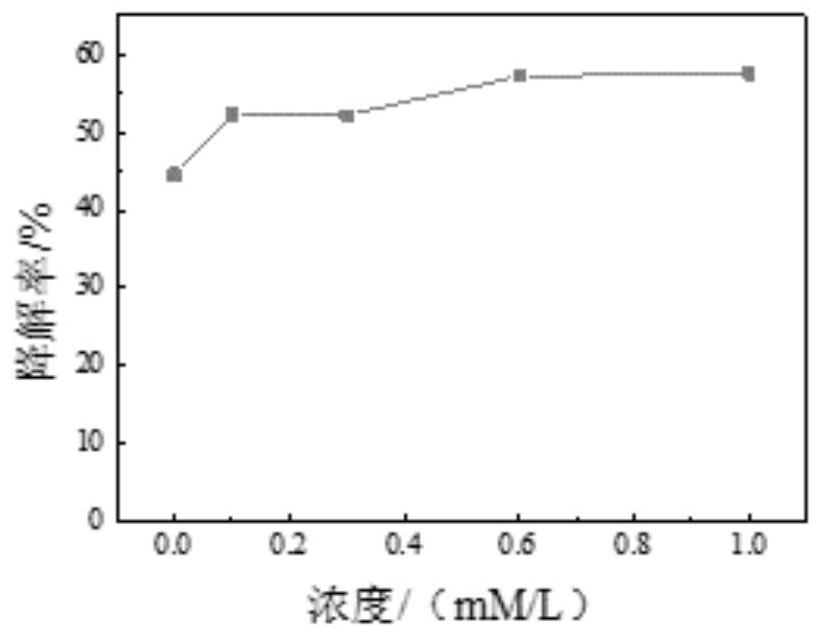Application of vanillin as a redox mediator in improving the degradation rate of diethylstilbestrol by laccase
A technology of diethylstilbestrol and vanillin, applied in the field of environmental pollution treatment, can solve the problems of slowing down photodegradation, insignificant effect, high cost and the like, and achieves the effects of simple operation, overcoming steric hindrance and kinetic limitation, and low cost
- Summary
- Abstract
- Description
- Claims
- Application Information
AI Technical Summary
Problems solved by technology
Method used
Image
Examples
Embodiment 1
[0031]Draw hexhene estroquinhenol standard curve
[0032]The concentration of 2.5 g / L was diluted, and the concentration of hexene escolol standard solution was obtained from 1 mg / L, 5 mg / L, 10 mg / L, 20 mg / L, 30 mg / L, 50 mg / L, and the HPLC detection method was drawn. Ciphethyrhenol standard curve, such asfigure 1 Indicated.
[0033]The HPLC detection condition is the column: Zorbax SB-C18 (150mm × 4.6mm × 5 μm); the detection conditions are: injection volume 10 μL, elution of the equal volume of acetonitrile and water to flow equal gradient, and the pump flow rate is 1.0 mL / MIN, column temperature: 30 ° C, UV detector detects peak conditions at 240 nm wavelength, record peak area.
Embodiment 2
[0035](1) 0.5 ml of 1 mg / ml of paint enzyme, 0 ml 0.01 mol / L of vanillal aldehyde solution and 0.4 ml of 2.5 g / L of DES mother liquor, and supplemented with acetic acid-acetate buffer to 10 ml, placed at 55 ° C , 120 rpm oscillating incubator reactions.
[0036](2) After the reaction was half an hour, the solution was extracted twice using ethyl acetate, and the organic phase was extracted and evaporated to dryness, and the methanol was allowed to sample, and the reaction was taken by the vacuum filter film. Measurement, calculate the degradation rate.
[0037]Degradation Rate Calculation Formula: Degradation Rate = (C0-C) / c0× 100%, where C0It is the initial concentration, and C is the final concentration.
[0038]After calculation, the degradation rate of this example is 44.56%.
Embodiment 3
[0040](1) 0.5 ml of 1 mg / ml of lacca, 0.1 ml 0.01 mol / L vanillal aldehyde solution and 0.4 ml of 2.5 g / L of DES mother liquor, and supplemented with acetic acid-acetate buffer to 10 ml, placed at 55 ° C , 120 rpm oscillating incubator reactions.
[0041](2) After the reaction was half an hour, the solution was extracted twice using ethyl acetate, and the organic phase was extracted and evaporated to dryness, and the methanol was allowed to sample, and the reaction was taken by the vacuum filter film. Measurement, calculate the degradation rate.
[0042]Degradation Rate Calculation Formula: Degradation Rate = (C0-C) / c0× 100%, where C0It is the initial concentration, and C is the final concentration.
[0043]After calculation, the degradation rate of this example is 52.25%.
PUM
 Login to View More
Login to View More Abstract
Description
Claims
Application Information
 Login to View More
Login to View More - R&D
- Intellectual Property
- Life Sciences
- Materials
- Tech Scout
- Unparalleled Data Quality
- Higher Quality Content
- 60% Fewer Hallucinations
Browse by: Latest US Patents, China's latest patents, Technical Efficacy Thesaurus, Application Domain, Technology Topic, Popular Technical Reports.
© 2025 PatSnap. All rights reserved.Legal|Privacy policy|Modern Slavery Act Transparency Statement|Sitemap|About US| Contact US: help@patsnap.com


